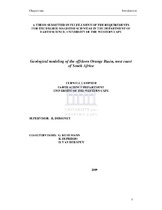| dc.description.abstract | Separation between the South American and African plate’s occurred along the present day Atlantic margin during the Middle to Late Jurassic leading to
the formation of a passive margin along the west coast of Southern Africa.
The margin then later developed into the large Orange Basin flanking the west
coasts of South Africa and Namibia. The Orange Basin on the west coast of
South Africa covers an area of roughly 130 000 square kilometers relevant to
the 200 m isobath and has roughly one well drilled for every 4000 square
kilometers. The basin has proven hydrocarbon reserves and potential for
further discoveries. The study area is located within South African exploration
licencing blocks 3A/4A and 3B/4B and covers a region of roughly 97 km by
150 km. The study aims at understanding the geological processes responsible for the formation of the Orange Basin with a focus on the evolution of source rock maturity. The methodology involved utilizing the Petrel software for seismic interpretation and well correlation utilising twodimensional seismic data and all the relevant well data including geological well logs, petrophysical well logs, well top data, check-shot data, borehole temperature data and geochemical well data such as Rock Eval and vitrinite reflectance data. PetroMod (IES, Version 10) was utilized to simulate the Orange Basin evolution and the affect on source rock maturity. Seismic interpretation of the Post-Hauterivian succession shows a relative thickening of the sedimentary sequence westward as the basin evolves from the early drift to complete drift phase. Results from the petroleum system modeling indicate that the Barremian - Early Aptian source rock is at present overmature and producing mostly gas in the shelf areas whereas the potential for oil are most likely present in the deep water area of the basin where Tertiary progradation has resulted in renewed petroleum generation. Petroleum system modeling results indicate that the younger Cenomanian - Turonian source rock is less mature than the older Barremian - Early Aptian source rock as indicated by a lower transformation ratio and is mainly producing oil. | en_US |

